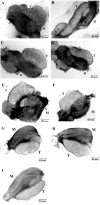Vascular endothelial growth factor and kinase domain region receptor are involved in both seminiferous cord formation and vascular development during testis morphogenesis in the rat
- PMID: 16672722
- PMCID: PMC2366204
- DOI: 10.1095/biolreprod.105.047225
Vascular endothelial growth factor and kinase domain region receptor are involved in both seminiferous cord formation and vascular development during testis morphogenesis in the rat
Abstract
Morphological male sex determination is dependent on migration of endothelial and preperitubular cells from the adjacent mesonephros into the developing testis. Our hypothesis is that VEGFA and its receptor KDR are necessary for both testicular cord formation and neovascularization. The Vegfa gene has 8 exons with many splice variants. Vegfa120, Vegfa164, and Vegfa188 mRNA isoforms were detected on Embryonic Day (E) 13.5 (plug date=E0) in the rat. Vegfa120, Vegfa144, Vegfa164, Vegfa188, and Vegfa205 mRNA were detected at E18 and Postnatal Day 3 (P3). Kdr mRNA was present on E13.5, whereas Fms-like tyrosine kinase 1 receptor (Flt1) mRNA was not detected until E18. VEGFA protein was localized to Sertoli cells at cord formation and KDR to germ and interstitial cells. The VEGFA signaling inhibitors SU1498 (40 microM) and VEGFR-TKI (8 microM) inhibited cord formation in E13 testis cultures with 90% reduced vascular density (P<0.01) in VEGFR-TKI-treated organs. Furthermore, Je-11 (10 microM), an antagonist to VEGFA, also perturbed cord formation and inhibited vascular density by more than 50% (P<0.01). To determine signal transduction pathways involved in VEGFA's regulation of testis morphogenesis, E13 testis were treated with LY 294002 (15 microM), a phosphoinositide 3-kinase (PI3K) pathway inhibitor, resulting in inhibition of both vascular density (46%) and cord formation. Thus, we support our hypothesis and conclude that VEGFA, secreted by the Sertoli cell, is involved in both neovascularization and cord formation and potentially acts through the PI3K pathway during testis morphogenesis to elicit its effects.
Figures







References
-
- Jost A, Magre S, Agelopoulou R. Early stages of testicular differentiation in the rat. Hum Genet. 1981;58:59–63. - PubMed
-
- Magre S, Jost A. The initial phases of testicular organogenesis in the rat: an electron microscopy study. Arch Anat Microsc Morphol Exp. 1980;69:297–318. - PubMed
-
- Albrecht KH, Eicher EM. Evidence that Sry is expressed in pre-Sertoli cells and Sertoli and granulosa cells have a common precursor. Dev Biol. 2001;240:92–107. - PubMed
-
- Capel B, Albrecht KH, Washburn LL, Eicher EM. Migration of mesonephric cells into the mammalian gonad depends on Sry. Mech Dev. 1999;84:127–131. - PubMed
-
- McLaren A. Development of the mammalian gonad: the fate of the supporting cell lineage. Bioassays. 1991;13:151–156. - PubMed
Publication types
MeSH terms
Substances
Grants and funding
LinkOut - more resources
Full Text Sources
Molecular Biology Databases
Miscellaneous

